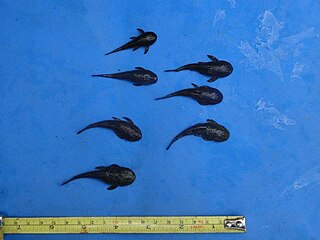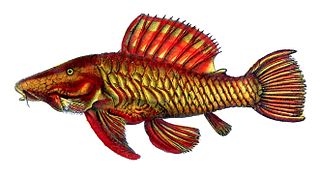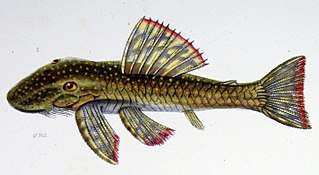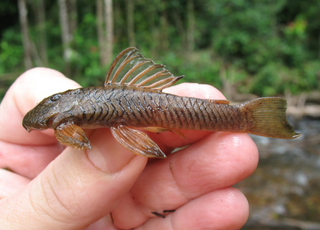
Pseudorinelepis genibarbis is a species of armored catfish native to Brazil, Peru, and Ecuador where it is found in the Amazon basin.

Pterygoplichthys, sometimes collectively known as janitor fish, is a genus of South American armored catfishes. These fish are commonly known as sailfin armoured catfish or sailfin plecs, especially in the aquarium trade.

Acanthicus is a genus of large, South American suckermouth armored catfishes native to the Amazon and Orinoco basins, and possibly in Guyana. The name Acanthicus is derived from the Greek, akanthikos meaning thorny, spiny. Fish of this genus are known as lyre-tail plecos. These species are found in large rivers, primarily in areas with a rocky bottom and a moderate or strong current.

Hypancistrus is a genus of loricariid catfish originating from the Amazon basin in South America. Unlike many of the other Loricariids, however, some Hypancistrus species are more carnivorous and enjoy meat in their diet. Hypancistrus species are popular aquarium fish, including such popular fish as the zebra pleco and Queen Arabesque pleco.
Scoloplax is the only genus in the catfish family Scoloplacidae, the spiny dwarf catfishes.

Peckoltia is a genus of small South American armored suckermouth catfishes. Many of these fish are popular aquarium fish.

Corymbophanes is a genus of armored catfish native to South America where they are only known from Guyana. Corymbophanes was originally placed in its own tribe Corymbophanini, but the first comprehensive molecular phylogenetic analysis of the subfamily Hypostominae found Corymbophanes to be nested within the tribe Ancistrini.
Pogonopoma is a genus of armored catfish native to rivers in south and southeast Brazil.

Rhinelepis is a genus of South American armored catfish.

Hopliancistrus tricornis is the only species of the genus Hopliancistrus of suckermouth armored catfish. This species reaches a length of 10.4 centimetres (4.1 in) SL. It is endemic to Brazil and can be found in the Tapajós and Xingu River basins. This species appears similar to members Lasiancistrus, however it lacks the synapomorphies and has five rows of plates on the caudal peduncle instead of three like those found in Lasiancistrus. It is characterized by three stout, strongly curved odontodes on either side of the head in males.

Parancistrus is a small genus of suckermouth armored catfishes native to South America.
Eurycheilichthys is a small genus of armored catfishes native to South America.
Isbrueckerichthys is a genus of armored catfishes which are endemic to Brazil.
Dekeyseria is a genus of suckermouth armored catfishes native to tropical South America.

Lasiancistrus is a genus of suckermouth armored catfishes. They are native to South America and Panama.
Paralithoxus is a genus of suckermouth armored catfishes native to tropical South America.

Homodiaetus is a genus of pencil catfishes native to South America.
Pseudolithoxus is a genus of suckermouth armored catfishes with five described species from the basins of the Orinoco, Casiquiare and upper Rio Negro in Venezuela. Additionally, a possibly undescribed species is known from the Trombetas and Nhamundá rivers in Brazil.

Guyanancistrus nassauensis is a species of catfish belonging to the family Loricariidae, the suckermouth armored catfishes. It is discovered in 2005 and formally described in 2018. G. nassauensis is a rare species, highly endemic to the Nassau Mountains in Suriname, and is threatened with extinction by proposed or ongoing mining activities.
Yaluwak is a genus of armored catfish native to South America where they are only known from Guyana, containing only a single species Yaluwak primus. It was first described in a 2020 study and placed within the tribe Ancistrini.












